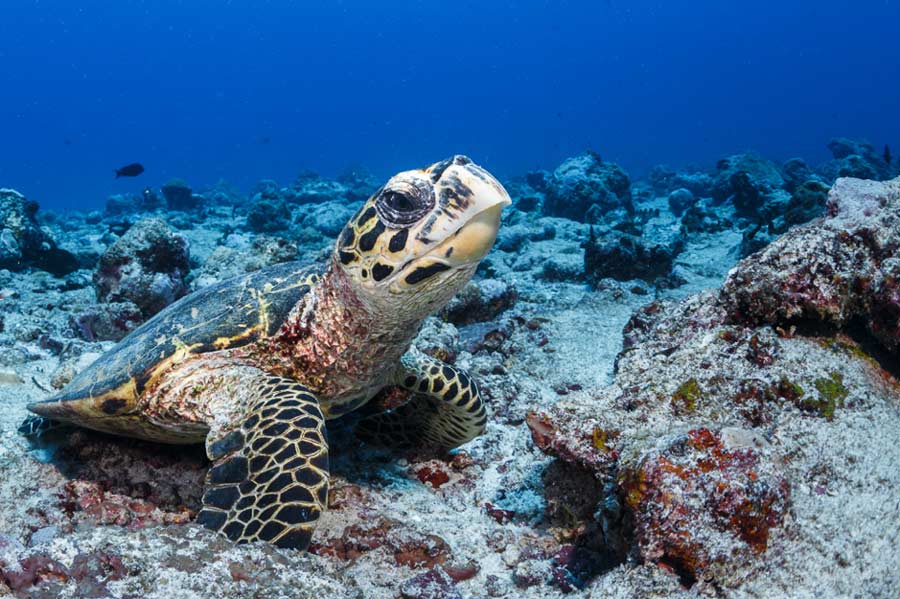
Scientific data shows that hawksbills, alongside Kemp’s ridleys, are the most endangered of the seven sea turtle species. With approximately 8,000 nesting females left globally, the critically endangered hawksbill turtle faces many threats. Here we explore just a few.
One of the smallest sea turtle species
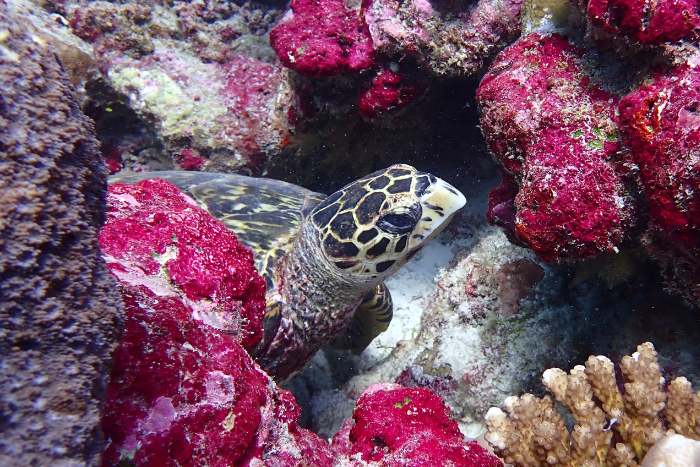
Hawksbill turtles (Eretmochelys imbricata) are amongst the smallest of the seven species of sea turtles. Adult hawksbills reach approximately 70-90cm in length and typically weigh between 45 and 70kg. They are easily identifiable by their unique carapace, the scutes of which overlap. Their narrow heads and beak-like jaws (from which they get their name) allow them to forage in the crevices of coral reefs, where they feed predominantly on sponges, anemones, soft corals, or other tasty marine invertebrates.
Hawksbills reside throughout the central tropical and part of the subtropical regions of the Atlantic and Indo-Pacific. In the first few years of their life, hawksbills inhabit open ocean environments, taking shelter under drifting algal mats called sargassum or other marine flotsam. Once they reach approximately 20-25cm in shell length, hawksbills recruit to coastal foraging areas, where they feed and grow.
Understanding the IUCN Red List classification
The IUCN Red List first listed the hawksbill turtle as endangered in 1968. Nearly three decades later, in 1996, the species was uplisted (moved up in the threat category) to Critically Endangered, as per the updated assessment criteria. The main reason for this reclassification included an observed or suspected population decline of at least 80% over the last three generations.
Population estimates for sea turtles are commonly based on observations and counts of nesting females and nests, as beaches are far more accessible to researchers than underwater habitats. A sharp global decline in hawksbill turtle nests was a key factor in the re-evaluation of the species as Critically Endangered. But what are the causes for these declines?
Prized for their beautiful tortoiseshell
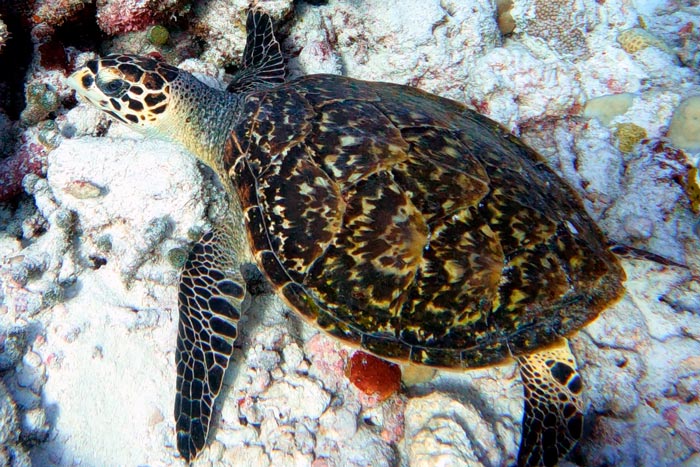
Hawksbill turtles have been highly valued for their beautiful carapace for thousands of years. Their scutes, streaked and marbled in colours of amber, yellow, black and brown have been used as ‘tortoiseshell’ or ‘bekko’ (Japanese), to fashion a variety of items including jewellery and other decorative objects.
Historical records of tortoiseshell trade date back to ancient civilisations of Egypt, the Roman Empire, China, and parts of the Arabian world. Traders often obtained sea turtles from remote regions, such as islands in present-day Indonesia and along the east coast of Africa. Similar trade routes existed in the Americas, highlighting the global scale and widespread demand for tortoiseshell.
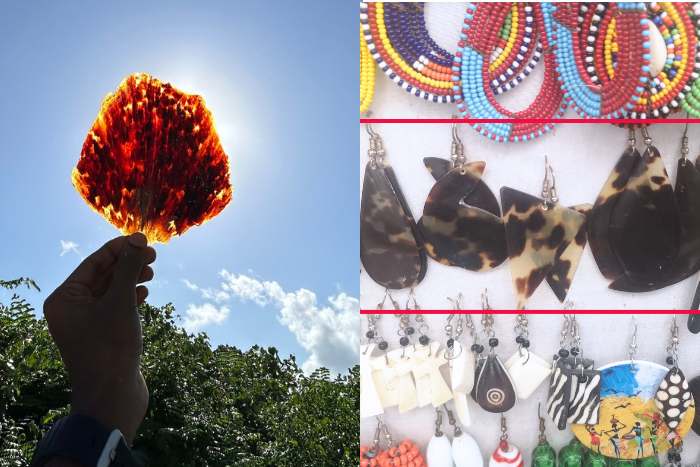
Over the past century alone, it’s estimated that millions of hawksbill turtles were killed to supply the markets of Europe, Asia and the United States. And despite domestic and international trade bans, the tortoiseshell trade remains a pervasive threat to sea turtles in the Americas and South East Asia.
Researchers argue that, because the trade in hawksbills continued well into the late 20th century, this species has experienced the most sustained and intense exploitation of all sea turtles. This long-term pressure has had a significant impact on their population numbers. Today, the species’ sporadic and widely dispersed nesting patterns are likely a direct consequence of this dramatic decline.
Why do we mostly see juvenile hawksbills in the Maldives?
Our Photo-ID research shows that most hawksbills spotted on Maldivian reefs are juveniles. This could be due to significant historic population declines, leading to fewer adults. But it’s also possible that these reefs naturally serve as key developmental habitats for young turtles to grow. Adult hawksbills might be using other, less-surveyed areas. These patterns highlight how crucial long-term
monitoring is in understanding sea turtle behaviour, habitat use, and recovery.
Hunted for their eggs & meat
Many cultures around the world harvest hawksbill turtle eggs for consumption, with some even believing the eggs to possess aphrodisiac properties. However, there is no scientific evidence to support this claim. On the contrary, extensive research has found that sea turtle eggs can contain high levels of pollutants, bacteria, and parasites, all of which may actually lower fertility rather than enhance it.
Sea turtles are also harvested for their meat, which is considered a delicacy in many cultures. Unfortunately, fishermen targeting lobster and reef fish may take hawksbill turtles when encountered. In some regions, fishermen will use sea turtle meat as shark bait.
Although such practices persist, the World Health Organisation (WHO) cautions against the consumption of hawksbill turtle meat. Hawksbills feed predominantly on toxin-containing sponges, which, if consumed, can result in neurotoxicity, kidney disease, liver cancer, developmental defects in unborn children, and even death. Despite this, harvesting hawksbills for consumption still continues, with occasional dire consequences of mass poisonings, as recorded in local news sources.
Bycatch & ghost fishing
Accidental capture in fishing gear (bycatch) is a huge threat to all sea turtles worldwide. Each year thousands of sea turtles are captured, injured or killed in active fishing gear. While many turtles drown when captured in nets (since they are unable to surface for air), little is known about the fate of injured turtles that are still alive on capture and are released by fishermen.
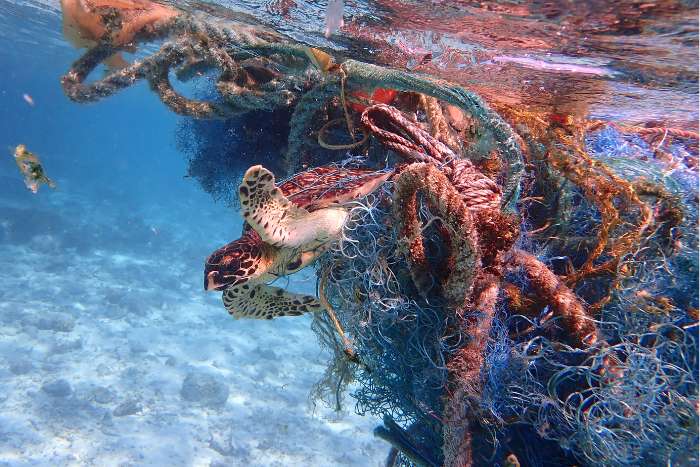
Another threat to hawksbills comes from ghost nets – commercial fishing nets that fishermen have lost, abandoned, or discarded at sea. These nets drift with ocean currents, travelling vast distances while continuing to trap and kill all marine life that crosses its path. This phenomenon, known as “ghost fishing,” is responsible for the deaths of millions of marine animals, including sea turtles.
Marine debris
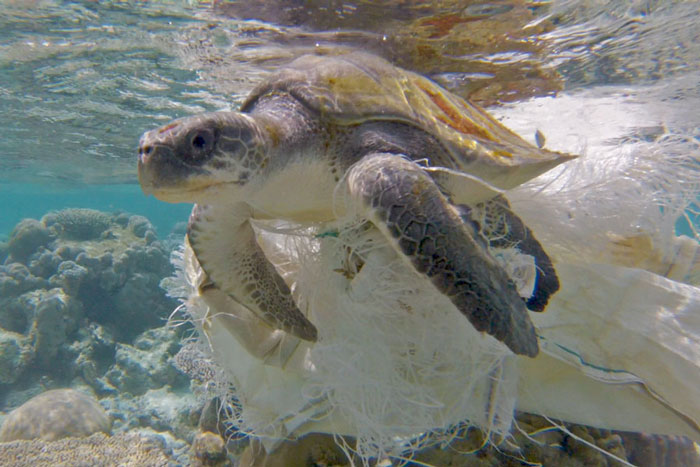
Beyond the ghost nets, other forms of marine debris like discarded plastics also pose a significant challenge to critically endangered hawksbills. With millions of tonnes of plastic entering the ocean each year, research suggests that nearly all sea turtles will ingest plastic at some point in their lives.
This poses a special danger to turtles because their throats have downward-facing spines (papillae) that prevent them from regurgitating ingested plastic. Once swallowed, the plastic can accumulate in the turtle’s stomach, blocking the digestive tract and creating a false sense of fullness. As a result, turtles may stop eating and eventually starve to death.
Marine debris doesn’t just affect the oceans. Scientists have also found microplastics on nesting beaches, where these tiny particles can change the physical properties of the sand and even raise nest incubation temperatures for sea turtles – a critical factor as sea turtle sex determination depends on temperature.
Did you know?
A global team of marine turtle experts, including scientists from the Olive Ridley Project sampled 209 nesting sites across six oceans, and found Microplastics on 45% of the beaches studied, with the Mediterranean showing the highest contamination at 80%.
Coastal development & beach erosion
Coastal development has a wide range of negative impacts on sea turtles, particularly on their nesting habitats. As human activities increasingly alter shorelines, critical nesting areas are either lost or degraded.
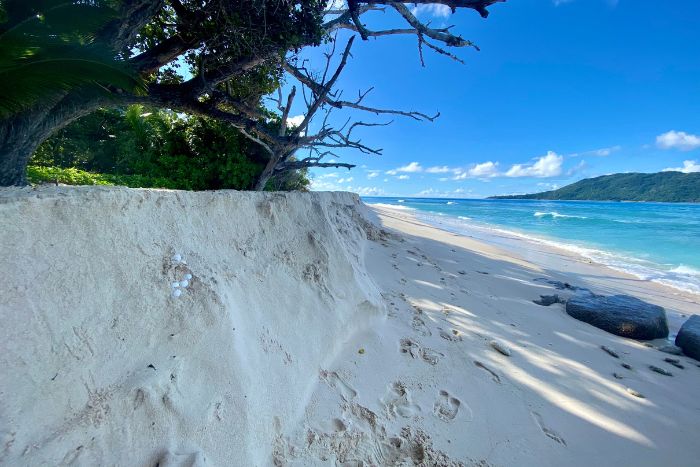
One such issue is beach erosion, exacerbated by coastal land development that disrupts natural sediment transport along shorelines. Eroding beaches leave little space for nesting females to lay their eggs, increasing the likelihood of nest flooding and failure. Ironically, artificial defence structures designed to prevent erosion, such as sea walls, can also pose a problem by blocking sea turtles’ access to suitable nesting habitat further up the beach.
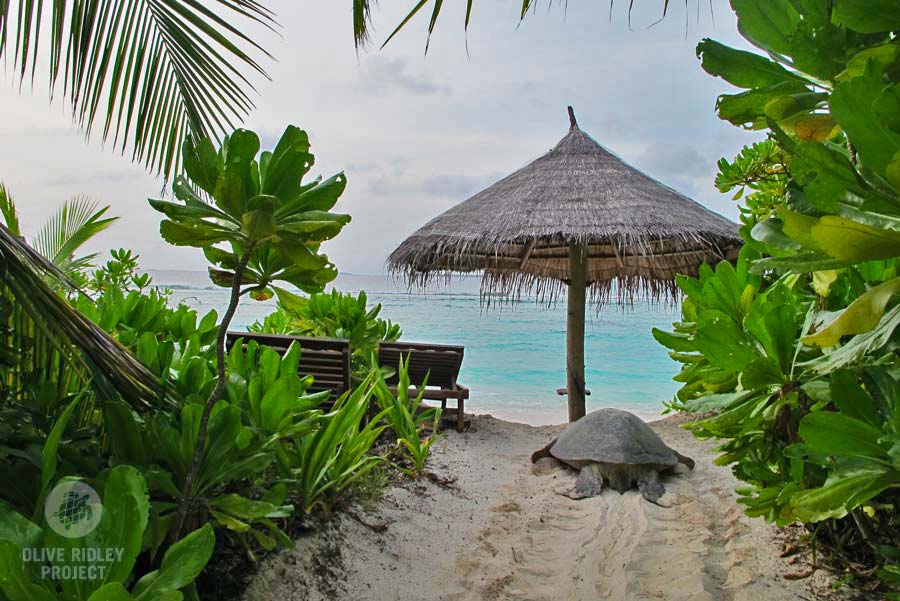
But that’s not all, beach furniture and recreation equipment, as well as nighttime activities on nesting beaches can further limit available nesting habitat and disturb females during the nesting process. Artificial lights on nesting beaches confuse and disorient nesting females and hatchlings, leading them inland rather than back towards the sea. This increases the risk of predators picking them off and even death due to dehydration or exhaustion.
Climate change

Climate change poses another significant threat to hawksbills, primarily through its devastating impact on coral reefs – the hawksbills’ primary foraging habitat. Hawksbills largely feed on sponges that grow on healthy reefs, tying their survival to the health of reef ecosystems.
However, rising ocean temperatures driven by global climate change are leading to frequent and severe coral bleaching events. High temperatures stress corals, causing them to expel the symbiotic algae (zooxanthellae) that provide them with energy and colour.This is why corals under stress appear white and bleached.
Therefore coral bleaching not only reduces the physical structure of reef habitats, but also makes them less suitable for turtle foraging and navigation.
Hope remains for hawksbills

Despite the many threats facing hawksbill turtles, there remains hope for hawksbill turtle populations. Public interest in hawksbills and other sea turtle species is at an all-time high and the demand for ecotourism is growing exponentially. As a result, not only is the implementation of regulations and protective measures gaining traction on regional and local scales, but more funds are becoming available for scientific research. In a promising development, over 140 researchers from around the world published a new global study: ““Updated Global Conservation Status and Priorities for Marine Turtles” showing that the overall conservation status of sea turtles has improved since the last global assessment in 2011.
Conservationists can identify population hot-spots through rigorous research, providing vital information for implementing protective legislation for sea turtles. Click here to find out more about the research Olive Ridley Project is currently undertaking.
What can you do to help hawksbill sea turtles?
- Learn more about hawksbill sea turtles by signing up for our free online e-Turtle School
- Share your knowledge with your peers to create awareness
- Adopt a wild hawksbill turtle for yourself or as a sustainable gift for a loved one
- Become a regular donor to support ORP’s sea turtle conservation efforts
References:
- Hays, G.C., Laloë, J.O. and Seminoff, J.A., 2025. Status, trends and conservation of global sea turtle populations. Nature Reviews Biodiversity, pp.1-15.
- Hudgins, Ali, and Mancini “Marine Turtles of the Maldives: A field identification and conduct guide“. An IUCN Publication funded by USAID. (2017).
- Mortimer & Donnelly (2008) “Eretmochelys imbricata The IUCN Red List of Threatened Species 2008”.
- Pavlin, B.I., Musto, J., Pretrick, M., Sarofalpiy, J., Sappa, P., Shapucy, S. and Kool, J., 2015. Mass poisoning after consumption of a hawksbill turtle, Federated States of Micronesia, 2010. Western Pacific surveillance and response journal: WPSAR, 6(1), p.25.
- Stelfox, Martin “Ghost Gear, The Silent Killers in Our Oceans“. Current Conservation Magazine Vol. 12 Issue 2, 2018:1 8-19.
- Botterell, Z. L. R., Ardren, J., Dove, E., McArthur, E., Addison, D. S., Adegbile, O. M., Agamboue, P. D., Agyekumhene, A., Allman, P., Alterman, A., Anderson, A., Arenholz, T., Ariano-Sánchez, D., Arnold, Z., Báez, J. C., Bahar, A., Barbosa, C., Barrios-Garrido, H., Başkale, E., Berumen, M. L., … Godley, B. J. (2025). A global assessment of microplastic abundance and characteristics on marine turtle nesting beaches. Marine Pollution Bulletin.
- Wallace, B. P., Bandimere, A. N., Abreu-Grobois, F. A., Acosta, H., Akiti, J., Akomedi, M., Alfaro-Shigueto, J., Allen, C. D., Angenda, D., Ayissi, I., Azanza Ricardo, J., Barrientos-Muñoz, K. G., Barrios-Garrido, H., Bjorndal, K. A., Bretón Vargas, E., Broderick, A. C., Calderón Peña, R., Carreras, C., Ceriani, S. A., … Mast, R. B. (2024). Updated global conservation status and priorities for marine turtles. Endangered Species Research.

